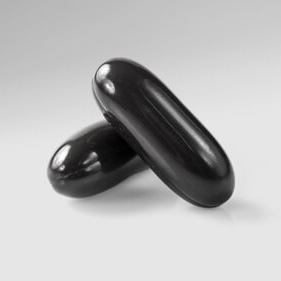It usually doesn’t take much for nature to impress us, whether it’s the breathtaking view of an Alaskan glacier or merely the perfect ray of sunlight as it hits a green leaf hanging from a tree. But when we start looking into the more extreme intricacies of the natural world, it becomes more than impressive. It can be life-changing. One prime example of the life-changing intricacies of nature is the signs it has left for us among its designs. For instance, most of us grew up hearing that we should eat our carrots because they are good for our eyes. And our parents were right — carrots are high in Vitamin A, which is an essential nutrient for healthy eyes 1 But have you ever sliced a carrot and taken a good look at its core?
If you have, you may have noticed something shocking. The core of a carrot looks like an eyeball. When sliced shortways, it has a dark center, and then it has a ring around that. And if you look even more closely, you might see veins, much like those of an eye. In the design of the carrot, nature has left us a sign: It is beneficial to the body part that it resembles!
And this theory of plants that resemble the body parts they might benefit doesn’t stop with carrots. Curiously, nature seems to have left more similar signs for us in other places. Consider, for example, the tomato.
This red, juicy fruit has four distinct chambers, just like a human heart. And what do you think the tomato might be beneficial for? Yep, you guessed it — the human heart. Tomatoes can help with cholesterol, blood pressure, inflammation, and heart attack.2
Other notable plants that benefit the organs they resemble include walnuts, which help brain function, and ginger, which can help with stomach pain. Fascinating, right?
What is the Doctrine of Signatures?
This concept is called the Doctrine of Signatures, and it dates as far back as 23-79 CE.3 In fact, although the concept was first recorded during this time period, in some circles the Doctrine of Signatures is believed to have originated far before that, in ancient Chinese medicine.4 And it makes perfect sense that our ancestors would rely on these signs from nature to help guide them in making noteworthy medical and scientific discoveries.
Think about it — at some point, humans had to figure out which plants were edible and which were not. In many cases, this was a life-or-death matter, so it seems only natural (pun intended) that they’d look for signs. Whether they were reliant upon their higher powers or simply trusting in the power of nature, the signs seemed abundant. They used symbolism, biological observation, intuition, and the study of medicinal properties5 to guide them as they identified plants that were good for them or plants that were bad for them.
So, is the Doctrine of Signatures Real?
While these ancient healers didn’t always turn out to be right, they were certainly right in some cases. In 1825, the father of homeopathy Samuel Hahnemann declared of the Doctrine of Signatures,6 “I shall spare the ordinary medical school the humiliation of reminding it of the folly of those ancient physicians who, determining the medicinal power of crude drugs from their signature, that is, from their color and form, gave the testicle-shaped Orchitis-root in order to restore manly vigour…” Essentially, relying only on the shape, color, and features of various plants to determine their efficacy in treating or preventing human illness seems illogical. And it can be a stretch, in some cases.
Yet, in many cases, illogical or not, foods that look like organs have been proven to actually be beneficial to those organs. Some scientists attribute this not to luck or creative design, but rather to the idea that aligning the shape or color of a plant with a body part that looks similar was an ancient method for remembering which body part it can help heal. Think of it as a mnemonic of sorts. This would help explain why we now know of so many plants that really are beneficial or curative for the organs or body parts they resemble — not because they were designed to heal that body part, but because their resemblance helped our ancestors remember what conditions they could be used to heal7 once they had learned of its power.
How Might the Doctrine of Signatures Help You?
While it isn’t practical to follow the Doctrine of Signatures to the letter, it certainly can’t hurt to take notes from some of its practices.
For example, it’s not a bad idea to remember which herbs, fruits, and vegetables help different parts of your body by remembering how they look. We’d never recommend relying solely on this philosophy to treat or cure illness, but it can be especially useful when trying to remember which foods can help strengthen or improve the wellness of different parts of your body.
For example, when you’re thinking about how to maintain your eyesight, you may remember to eat some extra carrots as a snack since their center looks like an eye. Similarly, if you’re worried about your heart health, you can remember by the tomato’s shape and color that they are good for your heart.
Here are a few other ways that this memory device can help you eat healthier to improve your overall health, as well as those specific parts of your body that may have you concerned.
-
- Ginger for Your Stomach
If you look at the bigger knob of ginger that trails off, it can be considered to resemble the stomach. Studies have shown that ginger can help soothe stomach issues like indigestion, nausea, and vomiting.8 - Walnuts for Your Brain
The odd shape of the brain closely resembling that of the walnut can help you remember that eating walnuts can have a beneficial effect in delaying the onset or even preventing Alzheimer’s9 as well as helping to improve memory. - Ginkgo Biloba for Your Brain
The nut of the Ginkgo Biloba tree looks like a brain, and its leaves mirrors the shape of the brain as well. Ginkgo is widely believed to have a positive impact on the brain and is known to improve memory and mood.10 - Eyebright for Eyes
The flower of Eyebright resembles a bloodshot eye, and the supplement is used to treat conjunctivitis and irritated eyes.11 - Avocado for Your Uterus (if you have one!)
The oval-like shape of an avocado is similar to the shape of a uterus, and the avocado is especially full of folate and potassium,12 two nutrients that are extremely beneficial for pregnant women.
- Ginger for Your Stomach
So while you definitely don’t want to start rummaging blindly about through your garden for a weed that resembles (and might treat!) the random rash you just got, the Doctrine of Signatures certainly can help provide a nice framework to help you remember which foods are good for you. Next time you’re thinking about your heart health or are sick to your stomach, think of the foods that resemble those organs, and have some as a snack. Those snacks just might be life-changing!
Feed Your Curiosity
If you want to be the first to know about new posts from our blog, join our email list to receive updates with helpful tips for living a healthy life.










